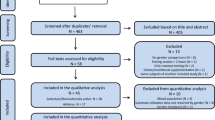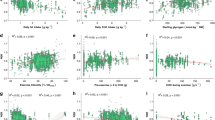Abstract
Research in Western populations has demonstrated a gender effect on substrate metabolism during exercise. Women have been shown to use more lipid and less carbohydrate as energy sources during endurance exercise, compared with their male counterparts. Nutritional status influences fuel utilization during exercise. Thai men and women routinely ingest a greater proportion of their dietary energy as carbohydrate than Caucasian individuals and thus may respond differently to exercise. Therefore, this study aimed to investigate the effects of gender on fuel utilization at different exercise intensities in untrained Thai individuals. Sixteen healthy sedentary men and 16 women participated in this study. All participants cycled at a target workload equivalent to 25, 65 and 85% maximum oxygen consumption continuously for 15, 10 and 10 min, respectively. Expired gas samples were collected for 30 min at rest and for the final 5 min of each exercise intensity. Actual relative exercise intensities were 32 ± 1.7, 64 ± 1.8, 84 ± 1.7% maximum oxygen consumption, respectively, and there was no significant difference between genders. Carbohydrate oxidation rate was higher than fat oxidation rate at every exercise intensity in both genders. In untrained Thai individuals, gender did not affect fuel utilization during sub-maximal exercise. The higher utilization of carbohydrate than fat at rest and during exercise in Thai individuals than seen previously in other populations may be due to the Thai’s habitual higher dietary carbohydrate intake.


Similar content being viewed by others
References
Achten J, Jeukendrup AE (2004) Optimizing fat oxidation through exercise and diet. Nutrition 20:716–727
Arkinstall MJ, Tunstall RJ, Cameron-Smith D et al (2004) Regulation of metabolic genes in human skeletal muscle by short-term exercise and diet manipulation. Am J Physiol Endocrinol Metab 287:E25–E31
Borg GA (1982) Psychophysical bases of perceived exertion. Med Sci Sports Exerc 14:377–381
Brooks GA, Mercier J (1994) Balance of carbohydrate and lipid utilization during exercise: the “crossover” concept. J Appl Physiol 76:2253–2261
Carter SL, Rennie C, Tarnopolsky MA (2001) Substrate utilization during endurance exercise in men and women after endurance training. Am J Physiol Endocrinol Metab 280:E898–E907
Chong MF, Hodson L, Bickerton AS et al (2008) Parallel activation of de novo lipogenesis and stearoyl-CoA desaturase activity after 3 d of high-carbohydrate feeding. Am J Clin Nutr 87:817–823
Coyle EF, Jeukendrup AE, Oseto MC et al (2001) Low-fat diet alters intramuscular substrates and reduces lipolysis and fat oxidation during exercise. Am J Physiol Endocrinol Metab 280:E391–E398
Davis SN, Galassetti P, Wasserman DH et al (2000) Effects of gender on neuroendocrine and metabolic counterregulatory responses to exercise in normal man. J Clin Endocrinol Metab 85:224–230
Devries MC, Hamadeh MJ, Graham TE et al (2005) 17beta-estradiol supplementation decreases glucose rate of appearance and disappearance with no effect on glycogen utilization during moderate intensity exercise in men. J Clin Endocrinol Metab 90:6218–6225
Durnin JV, Rahaman MM (1967) The assessment of the amount of fat in the human body from measurement of skinfold thickness. Br J Nutr 21:681–689
Foster-Powell K, Holt SH, Brand-Miller JC (2002) International table of glycemic index and glycemic load values: 2002. Am J Clin Nutr 76:5–56
Jeukendrup AE (2003) Modulation of carbohydrate and fat utilization by diet, exercise and environment. Biochem Soc Trans 3:1270–1273
Jurca R, Lamonte MJ, Barlow CE et al (2005) Association of muscular strength with incidence of metabolic syndrome in men. Med Sci Sports Exerc 37:1849–1855
Koutsari C, Hardman AE (2001) Exercise prevents the augmentation of postprandial lipaemia attributable to a low-fat high-carbohydrate diet. Br J Nutr 86:197–205
Koutsari C, Sidossis LS (2003) Effect of isoenergetic low- and high-carbohydrate diets on substrate kinetics and oxidation in healthy men. Br J Nutr 90:413–418
Maughan RJ, Williams C, Campbell DM et al (1978) Fat and carbohydrate metabolism during low intensity exercise: effects of the availability of muscle glycogen. Eur J Appl Physiol Occup Physiol 39:7–16
Péronnet F, Massicotte D (1991) Table of nonprotein respiratory quotient: an update. Can J Sport Sci 16:23–29
Roberts R, Bickerton AS, Fielding BA (2008) Reduced oxidation of dietary fat after a short term high-carbohydrate diet. Am J Clin Nutr 87:824–831
Romijn JA, Coyle EF, Sidossis LS et al (1993) Regulation of endogenous fat and carbohydrate metabolism in relation to exercise intensity and duration. Am J Physiol 265:E380–E391
Ruby BC, Robergs RA (1994) Gender differences in substrate utilisation during exercise. Sports Med 17:393–410
Schwarz JM, Linfoot P, Dare D et al (2003) Hepatic de novo lipogenesis in normoinsulinemic and hyperinsulinemic subjects consuming high-fat, low-carbohydrate and low-fat, high-carbohydrate isoenergetic diets. Am J Clin Nutr 77:43–50
Tarnopolsky MA (2000) Gender differences in substrate metabolism during endurance exercise. Can J Appl Physiol 25:312–327
Tarnopolsky MA (2008) Sex differences in exercise metabolism and the role of 17-beta estradiol. Med Sci Sports Exerc 40:648–654
Van Dam RM, Rimm EB, Willett WC et al (2002) Dietary patterns and risk for type 2 diabetes mellitus in U.S. men. Ann Intern Med 136:201–209
Van Loon LJ, Greenhaff PL, Constantin-Teodosiu D et al (2001) The effects of increasing exercise intensity on muscle fuel utilization in humans. J Physiol 536:295–304
Acknowledgments
This work has been supported by the Royal Thai government scholarship and research grant from Faculty of Medicine, Khon Kaen University, Thailand. We wish to thank all the participants for their cooperation. In addition, many thanks go to Associate Professor Dr. Chanvit Leelayuwat, Associate Professor Dr. Pranithi Hongspraphas who gave a good advice. We appreciate Associate Professor Jongonnee Wattanapermpool for her excellent assistance with critical commentary and suggestions.
Conflict of interest statement
No conflict of interest was reported by the authors of this paper.
Author information
Authors and Affiliations
Corresponding author
Rights and permissions
About this article
Cite this article
Janyacharoen, T., Auvichayapat, P., Tsintzas, K. et al. Effect of gender on fuel utilization during exercise at different intensities in untrained Thai individuals. Eur J Appl Physiol 107, 645–651 (2009). https://doi.org/10.1007/s00421-009-1167-6
Accepted:
Published:
Issue Date:
DOI: https://doi.org/10.1007/s00421-009-1167-6




